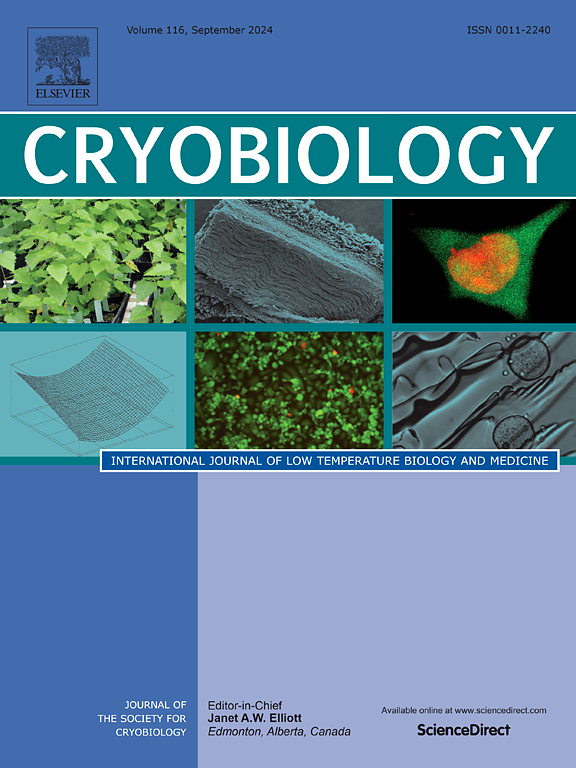猪未成熟卵母细胞和原核孤雌细胞的玻璃化在胚胎基因组激活时延迟发育:一项延时研究
IF 2.1
3区 生物学
Q2 BIOLOGY
引用次数: 0
摘要
尽管玻璃化对胚胎的生存能力有潜在的不利影响,但对于保存雌性种质和胚胎的储存和运输来说,玻璃化程序已成为必不可少的。本研究的目的是通过延时成像来研究玻璃化对猪胚胎发育动力学的影响。在第一个比较中,在体外成熟(IVM)和人工激活(AA)之前,处于生发囊(GV)阶段的卵母细胞被玻璃化加热或未玻璃化(对照组)。在第二个比较中,IVM和AA后产生的原核(PN)孤雌子要么玻璃化加热,要么不玻璃化(对照)。使用Primo Vision延时系统监测胚胎发育6 d,并在标准体外培养(IVC)条件下孵育后评估相应的队列。玻璃化组胚胎进入大多数发育阶段的累积时间明显长于对照组。分析每个发育间隔的持续时间显示,与对照组相比,玻璃化组的4至5细胞和5至8细胞周期明显较慢。GV卵母细胞玻璃化后,非典型囊胚分裂的发生率有增加的趋势。在标准IVC条件下,玻璃化组胚胎的囊胚形成率低于对照组。考虑到猪胚胎中最大的发育延迟期与主要的胚胎基因组激活期一致,我们提出GV卵母细胞和PN孤雌细胞的玻璃化对表观遗传过程产生不利影响。本文章由计算机程序翻译,如有差异,请以英文原文为准。
Vitrification of porcine immature oocytes and pronuclear parthenotes delays development at the time of embryonic genome activation: A time-lapse study
Vitrification procedures have become indispensable for the preservation of female germplasm and the storage and transport of embryos despite the potential detrimental effects on embryo viability. The aim of this study was to examine the effects of vitrification on porcine embryo developmental kinetics by time-lapse imaging. In the first comparison, cumulus enclosed oocytes at the germinal vesicle (GV) stage were either vitrified-warmed or not vitrified (control) prior to in vitro maturation (IVM) and artificial activation (AA). In the second comparison, pronuclear (PN) parthenotes produced after IVM and AA were either vitrified-warmed or not vitrified (control). Embryo development was monitored for 6 d using the Primo Vision time-lapse system, and corresponding cohorts were assessed after incubation under standard in vitro culture (IVC) conditions. The cumulative time taken to progress to most of the developmental stages was significantly longer for embryos of the vitrified groups than for those of the control groups. Analysing the duration for each developmental interval revealed that the 4- to 5-cell and 5- to 8-cell periods were remarkably slower in the vitrified groups, compared with the control groups. The incidence of atypical blastomere divisions tended to increase following vitrification of GV oocytes. Under standard IVC conditions, blastocyst formation rates were lower for embryos of the vitrified groups than for those of the control groups. Given that the period of greatest developmental delay coincides with the major embryonic genome activation phase in porcine embryos, we propose that the vitrification of GV oocytes and PN parthenotes adversely impacts epigenetic processes.
求助全文
通过发布文献求助,成功后即可免费获取论文全文。
去求助
来源期刊

Cryobiology
生物-生理学
CiteScore
5.40
自引率
7.40%
发文量
71
审稿时长
56 days
期刊介绍:
Cryobiology: International Journal of Low Temperature Biology and Medicine publishes research articles on all aspects of low temperature biology and medicine.
Research Areas include:
• Cryoprotective additives and their pharmacological actions
• Cryosurgery
• Freeze-drying
• Freezing
• Frost hardiness in plants
• Hibernation
• Hypothermia
• Medical applications of reduced temperature
• Perfusion of organs
• All pertinent methodologies
Cryobiology is the official journal of the Society for Cryobiology.
 求助内容:
求助内容: 应助结果提醒方式:
应助结果提醒方式:


